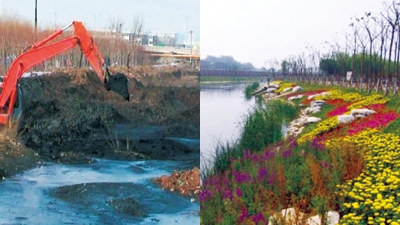Overview
The Hai Basin Integrated Water and Environment Management Project (September 2004 - June 2011) has effectively promoted an integrated approach to water resource management and pollution control in the Hai Basin in northern China and contributed to the restoration and protection of marine environment, ecosystem and biodiversity in the Bohai Sea.
The project was implemented in 16 counties in northern China. Over 20 million people benefited from it.
Challenge
The Hai Basin spreads over six provinces and the municipalities of Beijing and Tianjin, which account for 15 percent of China’s GDP. It suffered from serious water-related problems, including water pollution, water scarcity, diminishing water supplies and flooding. Water availability per capita in the Hai Basin was only 14 percent of the national average and about four percent of the global average.
Over-exploitation of groundwater, overuse of surface water resulting in inadequate environmental flows, along with groundwater and surface water pollution, led to the decline and deterioration of water resources and damaged the freshwater and coastal environments of the Hai Basin.
The Basin discharges into the Bohai Sea, which is an important ecosystem and fishery resource. However, heavy land-based pollution from urban, industrial, agricultural, and other sources in the Hai Basin, combined with overfishing, reduction of freshwater inflows, and habitat loss, threatened the fishery and steadily diminished many of the Bohai Sea’s ecological functions.
Approach
To address these problems in the Hai Basin and the connected Bohai Sea ecosystem, the World Bank helped the Chinese Government develop and implement an integrated approach to water and environmental management. The project was designed to play an important role in these efforts.
Integrated water and environment management (IWEM) planning is a key management measure promoted by the project. It provides the context (within law, policy, institutional arrangements, and operational practices) for the development of practical approaches to carry out top-down, bottom-up, vertical and horizontal cooperation at the basin, sub-basin and county level that redress land-based activities that degrade marine waters.
Another innovative approach introduced by the project is evapotranspiration (ET) management, with the aim of achieving real water savings to eliminate groundwater overdraft and provide more surface water for ecological purposes and as outflow to the Bohai Sea. Remote sensing and geographic information system (GIS) techniques were used to develop Basin-level ET reduction plans.
Furthermore, the project promoted improved coordination at all levels to overcome the institutional barriers to IWEM.
Results
- Integrated and coordinated management of water resources and environment The project established a mechanism for cooperation between water and environment departments at the central, provincial, and local levels.
- Reduced discharge of wastewater and key pollutants Annual wastewater discharge inthe 16 project counties in 2010 was 129.34 million tons less than that of 2004; COD and NH3-N discharge was 69,758 tons and 7,488 tons less.
- Controlled groundwater over-exploitation Total amount of over-exploited shallow groundwater for agricultural irrigation in the 16 project counties in 2010 was 63.2 percent less than that of 2004; deep groundwater exploitation was down by 46 percent.
- Reduced ET Value In 2010 the 16 project counties had an average ET of 549.6 mm, down by 54 mm from the 2004 level.
- Yingcheng Wastewater Treatment Plant in Hangu District, Tianjin, was built, and financial incentives for wastewater treatment were put in place in the small towns of Tianjin.
- Clearing of key pollutants in the Dagu Canal in the Hai Basin The project cleaned a total of 6.26 million m3 of pollutant sediment in the Dagu Canal. It also cleared 28,670 tons of oil, 1,820 tons of zinc, and 13,378 tons of total nitrogen from the Canal.
- Public participation Over 400 water users associations were established so that the communities decided themselves on how they manage water resources, particularly on water savings and operation and maintenance of the on-farm water systems.
- Practical approaches to improving water and environment management were developed, which can be replicated throughout the Hai Basin and in other Chinese basins.

